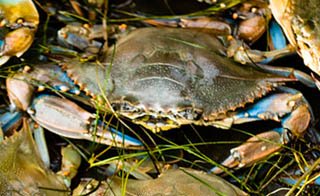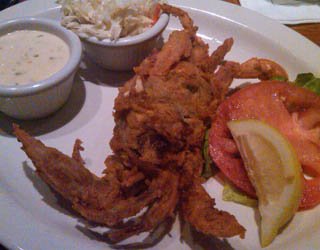Blue crab Nutrition facts
The Atlantic blue crab, scientifically known as Callinectes sapidus, is a swimming crustacean indigenous to the estuaries along the Eastern Atlantic coast. Renowned for its delectably sweet flavor, crab meat from this species holds a special place in the hearts of many in the United States. It is particularly iconic in the Chesapeake Bay region.
This crab is also commonly referred to as the Atlantic blue crab, jimmies (for males), and Chesapeake blue crab.
 |
| Blue crab- Callinectes sapidus. |
Characteristics
The blue crab is a swift-swimming crustacean, supported by a pair of paddle-shaped rear swimming legs. Its carapace, or shell, boasts a smooth, olive-green hue, while mature females display brilliant blue claws with red tips. Adult males can attain a diameter of up to 9 inches and live for around three years.
Distinguishing features include narrow, inverted T-shaped abdomens in males (known as "Jimmies") and broad, rounded abdomens in mature females (referred to as "sooks").
Blue crabs grow continuously, molting several times during their lifespan. During the immediate post-molt stage, they have an almost transparent body, earning them the name "soft-shelled crab."
Habitat
Blue crabs inhabit a variety of environments, including the open sea, rivers, and brackish waters along coastal shelves and estuaries. They exhibit an omnivorous diet, consuming everything from plant and animal detritus to clams, oysters, mussels, smaller crustaceans, and freshly deceased fish.
Life Cycle
The reproductive behavior of blue crabs is distinct. Mating occurs from May through October in brackish waters. Prior to mating, males cradle a soft-shelled female in their legs, carrying her for several days until she molts. After mating, the male continues to support the female until her shell hardens.
Females develop an external egg mass, a bright-orange sponge, beneath their abdomen. Within approximately two weeks, larvae are released into the water. These larvae eventually find their way to sea waters but return to estuaries and rivers to mature into full-sized adult crabs. Their lifespan typically spans around three years.
Health advantages of Blue Crab
Blue crab, as a crustacean, offers a low-calorie, low-fat, and white meat seafood option. For instance, 100 grams of its claw meat contains just 87 calories and 1.08 grams of fat.
Its lean, white meat serves as an excellent source of protein, containing 18.06 grams per 100 grams (equivalent to 32% of the Recommended Daily Intake). This protein is complete, providing all essential amino acids in a healthy proportion.
Research studies indicate that seafood consumption can reduce the risk of heart attacks, strokes, obesity, and hypertension. Seafood is low in saturated fat and rich in "heart-healthy" polyunsaturated fat, including omega-3 fatty acids. The American Heart Association recommends seafood due to its diverse range of nutrients, essential fatty acids, vitamins, and minerals that play vital roles in the body.
Blue crab meat also provides valuable nutrients such as folates, niacin, vitamin B6, thiamin, and riboflavin.
Crabs, as invertebrates, occupy the lower end of the food chain, accumulating only trace amounts of heavy metals like mercury. The Food and Drug Administration (FDA) recommends that pregnant women consume at least 8 to 12 ounces (about 340 grams) of seafood with low mercury content per week.
100 g fresh blue carb meat provides 9 μg or 375% of daily-required levels of vitamin B-12. Vitamin B12 plays a crucial role in supporting red blood cell formation, neurological function, DNA synthesis, and overall cell metabolism within the body.
Blue crabs are an abundant source of essential minerals, including iron (9% of the Recommended Daily Intake), selenium (68% of the RDI), iodine, calcium, zinc (32% of the RDI), potassium, phosphorus (33% of the RDI), and magnesium.
| Principle | Nutrient Value | Percent of RDA |
|---|---|---|
| Energy | 87 Kcal | 4.35% |
| Carbohydrates | 0.04 g | <1% |
| Protein | 18.06 g | 32% |
| Total Fat | 1.08 g | 5% |
| Cholesterol | 78 mg | 20% |
| Dietary Fiber | 0 g | 0% |
| Vitamins | ||
| Folates | 44 μg | 11% |
| Niacin | 2.7 mg | 17% |
| Pyridoxine | 0.15 mg | 11% |
| Riboflavin | 0.04 mg | 3% |
| Thiamin | 0.08 mg | 6.5% |
| Vitamin-A | 5 IU | <1% |
| Vitamin B-12 | 9 μg | 375% |
| Vitamin-C | 3 mg | 3.25% | Electrolytes |
| Sodium | 293 mg | 19.5% |
| Potassium | 329 mg | 7% |
| Minerals | ||
| Calcium | 89 mg | 9% |
| Copper | 0.669 mg | 74% |
| Iron | 0.74 mg | 9% |
| Magnesium | 34 mg | 8.5% |
| Manganese | 0.15 mg | 7% |
| Phosphorus | 229 mg | 33% |
| Selenium | 37.4 μg | 68% |
| Zinc | 3.54 mg | 32% |
| Omega-3 fats (PUFA) | ||
| EPA (20:5 n-3) | 0.17 g | -- |
| DPA (22:5 n-3) | 0 g | -- |
| DHA (22:6 n-3) | 0.15 g | -- |
Buying
When purchasing crab, opt for a live crab to guarantee its freshness. Typically, you'll want to cook it by immersing it in boiling water. Alternatively, you can place the live crab in cold water and gradually bring it to a boil.
Storing
Store the crab wrapped in a damp cloth inside the refrigerator.
Preparation- How to remove meat from crab?
- Lay the crab on its back on a spacious cutting board.
- Securely hold the crab with one hand and detach the tail flap, discarding it.
- Unbend and twist the tail to remove it.
- Use a nutcracker (lobster cracker) to break open the claws and legs, then extract the meat.
- Stand the crab on its head and insert a sturdy knife between the body and shell. Twist the knife to separate them, allowing you to lift out the honeycomb body.
- Remove the spongy stomach sac and cut it into quarters.
- Use a spoon to scoop out the creamy brown meat from the back of the shell.
- The yield of crab meat is approximately 35%.
After cooking, the claws and shell will turn maroon, regardless of their original color..
Here are some serving ideas:
 |
| Blue crab- Callinectes sapidus. Photo courtesy Michelle |
Devilled crab, where the meat is removed from the shell and cooked with mustard, horseradish, and spices.
Crab mornay, where the meat is combined with a gruyere cheese sauce enriched with sherry and mushrooms.
Crabmeat works wonderfully in dishes like Thai fishcakes and soups.
Soft-shell crabs can be lightly coated in flour and deep-fried. Try "Moheche fritte" (molted crab), a Venetian specialty where crabs are soaked in beaten eggs before frying.
In China, soft-shelled crabs are served with a spicy garnish of chilli or fresh root ginger.
Safety profile
Allergy to crustaceans may affect around 1% of the population and is more common in teenagers and adults than in very young children.
Many allergic reactions to seafood result in mild symptoms like hives (urticaria), tingling of the throat and mouth, swelling (angioedema), and gastrointestinal reactions (vomiting, diarrhea).
Blue crab's methyl mercury levels is 0.065 Parts Per Million (PPM). According to the U.S. FDA guidelines for expectant and breastfeeding mothers, blue crab falls into the "best choice" category, allowing for 2-3 servings per week.
(Medical disclaimer).Also read ≻≻-
≺≺ Shrimp nutrition facts and health advantages.
≺≺ Lobster nutrition facts and health benefits.
≺≺ Trout nutrition facts and health benefits.
≺≺ Anchovies nutrition facts and health benefits.
≺≺ Back to Seafood from Blue crab nutrition facts and health advantages.
Further reading (Links opens in new window):
Chesapeakebay blue crab program-Callinectes sapidus.
Omega-3 Fatty Acids: An Essential Contribution.